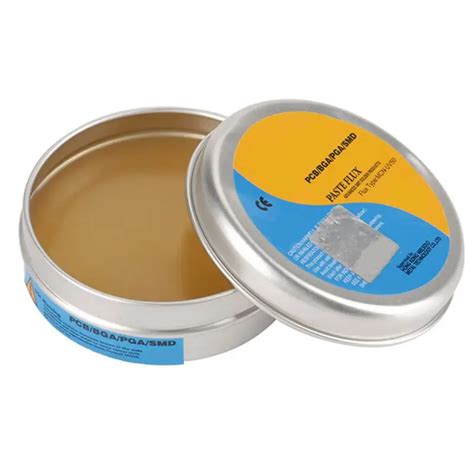What Is Solder Flux?
Solder flux is a chemical compound or mixture applied to the surfaces of metals prior to or during the soldering process. Its primary functions are to:
- Remove oxides and other contaminants from the metal surfaces
- Prevent oxidation during the soldering process
- Improve the flow and wetting characteristics of molten solder
- Promote the formation of a strong and reliable solder joint
Solder flux is available in various forms, including liquids, pastes, and solids, each with specific properties and applications.
Types of Solder Flux
There are four main types of solder flux, categorized based on their composition and activity level:
1. Rosin Flux
Rosin flux is the most common type of flux used in electronics soldering. It is derived from pine tree sap and is available in three activity levels:
- Mildly Activated (RMA): Contains small amounts of activators and is suitable for clean metal surfaces.
- Activated (RA): Contains higher levels of activators and is used for moderately oxidized surfaces.
- Highly Activated (HA): Contains aggressive activators and is used for heavily oxidized or contaminated surfaces.
Rosin flux is available in liquid, paste, and solid forms.
2. Water-Soluble Flux
Water-soluble flux is a more active alternative to rosin flux, designed for surfaces that are difficult to solder. It typically contains organic acids and is easily removed with water after soldering. However, water-soluble flux can be corrosive if not thoroughly cleaned post-soldering.
3. No-Clean Flux
No-clean flux is formulated to leave minimal residue after soldering, eliminating the need for post-soldering cleaning. This type of flux is ideal for applications where cleaning is difficult or impossible. However, no-clean flux may not be as effective as other types on heavily oxidized surfaces.
4. Inorganic Acid Flux
Inorganic acid flux is the most aggressive type of flux, containing strong acids like hydrochloric acid or zinc chloride. It is primarily used for soldering non-electronic metals, such as copper pipes or sheet metal. Inorganic acid flux requires thorough cleaning after soldering to prevent corrosion.

How to Use Solder Flux
Using solder flux correctly is crucial for achieving strong and reliable solder joints. Follow these steps for effective flux application:
Step 1: Clean the Surfaces
Before applying flux, clean the metal surfaces to remove dirt, grease, and loose oxides. Use isopropyl alcohol or a dedicated electronic cleaner for the best results.
Step 2: Apply the Flux
Apply a thin, even layer of flux to the metal surfaces using a brush, applicator, or by dipping the component leads into the flux. Avoid applying too much flux, as it can lead to splattering or bridging during soldering.
Step 3: Heat and Apply Solder
Heat the fluxed area with a soldering iron or torch, depending on the application. Once the flux becomes active and the metal reaches the appropriate temperature, apply the solder to the joint. The molten solder should flow smoothly and evenly, wetting the surfaces and creating a strong bond.
Step 4: Clean the Joint (if necessary)
If using a flux that requires post-soldering cleaning, such as water-soluble or inorganic acid flux, thoroughly clean the soldered joint with the appropriate solution (water or a specified cleaner) to remove any residue. Failure to clean the joint properly can lead to corrosion or poor performance over time.
| Flux Type | Cleaning Required | Ideal For |
|---|---|---|
| Rosin | Optional | Electronics |
| Water-Soluble | Yes (with water) | Difficult-to-solder surfaces |
| No-Clean | No | Applications where cleaning is impractical |
| Inorganic Acid | Yes (with specified cleaner) | Non-electronic metals |

Frequently Asked Questions (FAQ)
1. Can I use solder without flux?
While it is possible to solder without flux, it is not recommended for most applications. Flux is essential for removing oxides, preventing oxidation during soldering, and promoting proper solder flow and wetting. Soldering without flux can result in weak, unreliable joints and difficulties in achieving proper bonding.
2. Is solder flux toxic?
Some types of solder flux can be toxic or harmful if inhaled or ingested. Rosin flux fumes can cause respiratory irritation, while inorganic acid flux can cause severe burns. Always use solder flux in a well-ventilated area, wear appropriate personal protective equipment (PPE), and avoid breathing in fumes or touching flux with bare skin.
3. Can I mix different types of solder flux?
Mixing different types of solder flux is not recommended, as they may have incompatible chemical compositions that can negatively affect soldering performance or lead to corrosion. Always use the appropriate flux for the specific application and follow the manufacturer’s guidelines.
4. How long does solder flux last?
The shelf life of solder flux varies depending on the type and storage conditions. Most fluxes can last for several years when stored in a cool, dry place and in their original, sealed containers. However, flux exposed to air, moisture, or high temperatures may degrade faster. Always check the manufacturer’s recommendations for storage and shelf life.
5. Can I reuse solder flux?
Reusing solder flux is generally not advised, as it may accumulate contaminants or lose its effectiveness over time. Flux that has been exposed to high temperatures or has come into contact with molten solder may have altered chemical properties that can negatively impact soldering performance. It is best to use fresh flux for each soldering session to ensure optimal results.

Conclusion
Solder flux is a crucial component in the soldering process, ensuring strong, reliable bonds between metals. By understanding the different types of flux and their applications, as well as following proper usage techniques, you can achieve high-quality solder joints in various projects. Remember to always prioritize safety, use the appropriate flux for your specific needs, and clean soldered joints when necessary to prevent corrosion and maintain the integrity of your soldered connections.

Leave a Reply